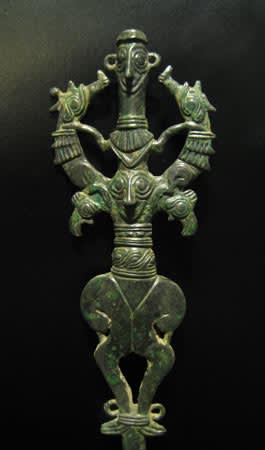Luristan Bronze Standard Finial, 900 BCE - 600 BCE
Bronze
2.75 x 15
AM.0178
This finial was produced in the era when the Luristan metal workshops were at their most prolific, c. 900-600 B.C. Similar designs can be found on a range of items...
This finial was produced in the era when the Luristan metal workshops were at their most prolific, c. 900-600 B.C. Similar designs can be found on a range of items including horse gear, axes and hair and clothing pins. These were all burial items distinguished by a large repertory of animal motifs, both real and imagined. By this period bronze was reserved for decorative artefacts that symbolised social standing among the communities of the Zagros mountains; more mundane, utilitarian objects were made of iron. The hallmark of Luristan wares is the tendency to elongate the necks, tails and bodies of the animals to produce graceful curves and arches. The re-discovery of the splendour of Luristan metalwork began in the 1930s and made considerable progress after World War II. The absence of relevant written records makes their complex imagery difficult to interpret in specific religious terms but it is likely that they represent local deities of some kind. It has been suggested that such elaborate bronze items must have been the preserve of the tribal leaders, a warrior class with the means to equip themselves and their households for war.
This magnificent example belongs to a group known as the master/mistress of the beasts. The central figure has an elongated neck with two faces. The lower part of the neck is heavily adorned with two bands of patterned motifs. The arms reach out to grasp the necks of the pair of mythological creatures that form two semi-circles. Below the hind legs of these creatures are two cock heads facing outwards. One of the striking features of such bronzes is the focus on wild rather than domesticated animals. This may reflect the experience of this community of mountain hunters when such predatory animals were part of everyday experience.
For similar examples see G. Markoe ed., Ancient Bronzes, Ceramics and Seals, (Los Angeles, 1981), especially p. 57, fig. 236.
This magnificent example belongs to a group known as the master/mistress of the beasts. The central figure has an elongated neck with two faces. The lower part of the neck is heavily adorned with two bands of patterned motifs. The arms reach out to grasp the necks of the pair of mythological creatures that form two semi-circles. Below the hind legs of these creatures are two cock heads facing outwards. One of the striking features of such bronzes is the focus on wild rather than domesticated animals. This may reflect the experience of this community of mountain hunters when such predatory animals were part of everyday experience.
For similar examples see G. Markoe ed., Ancient Bronzes, Ceramics and Seals, (Los Angeles, 1981), especially p. 57, fig. 236.
